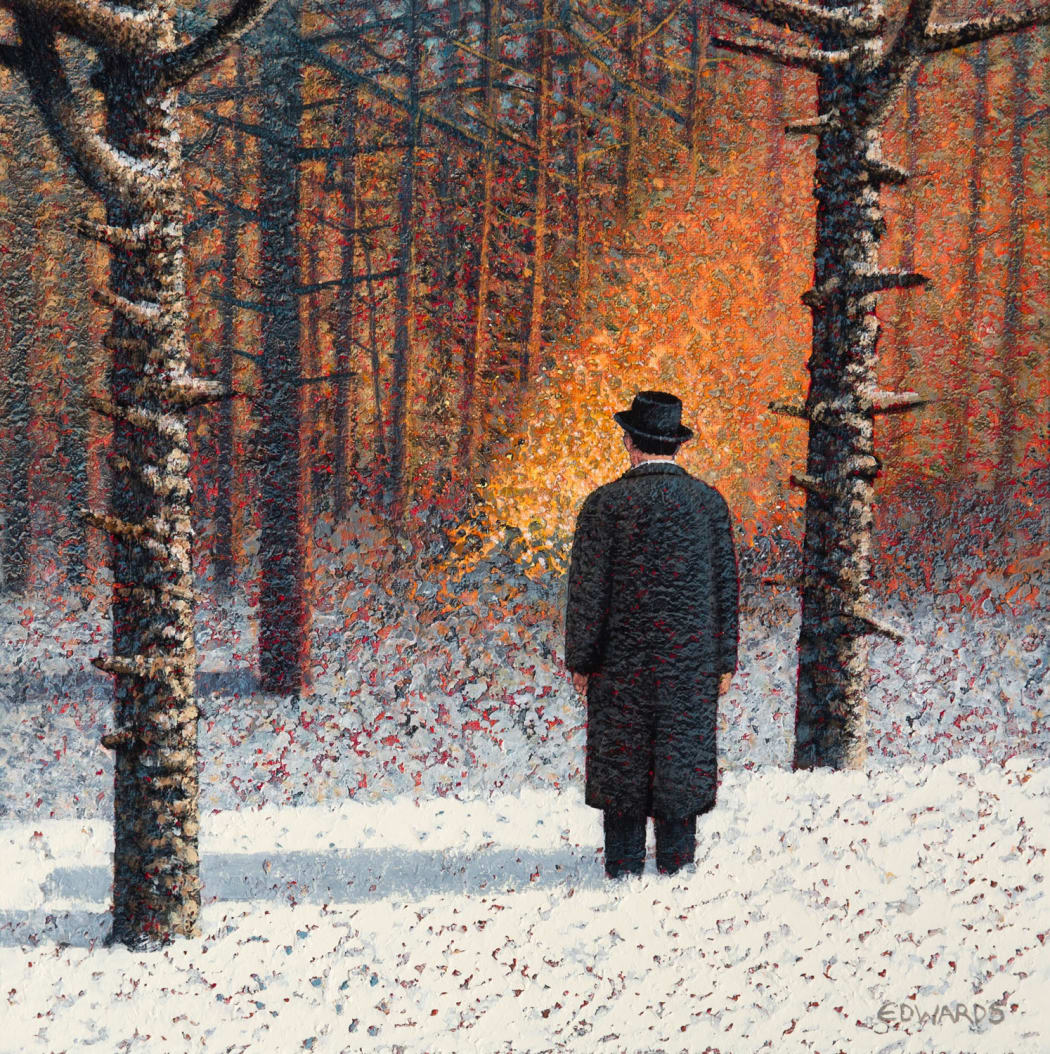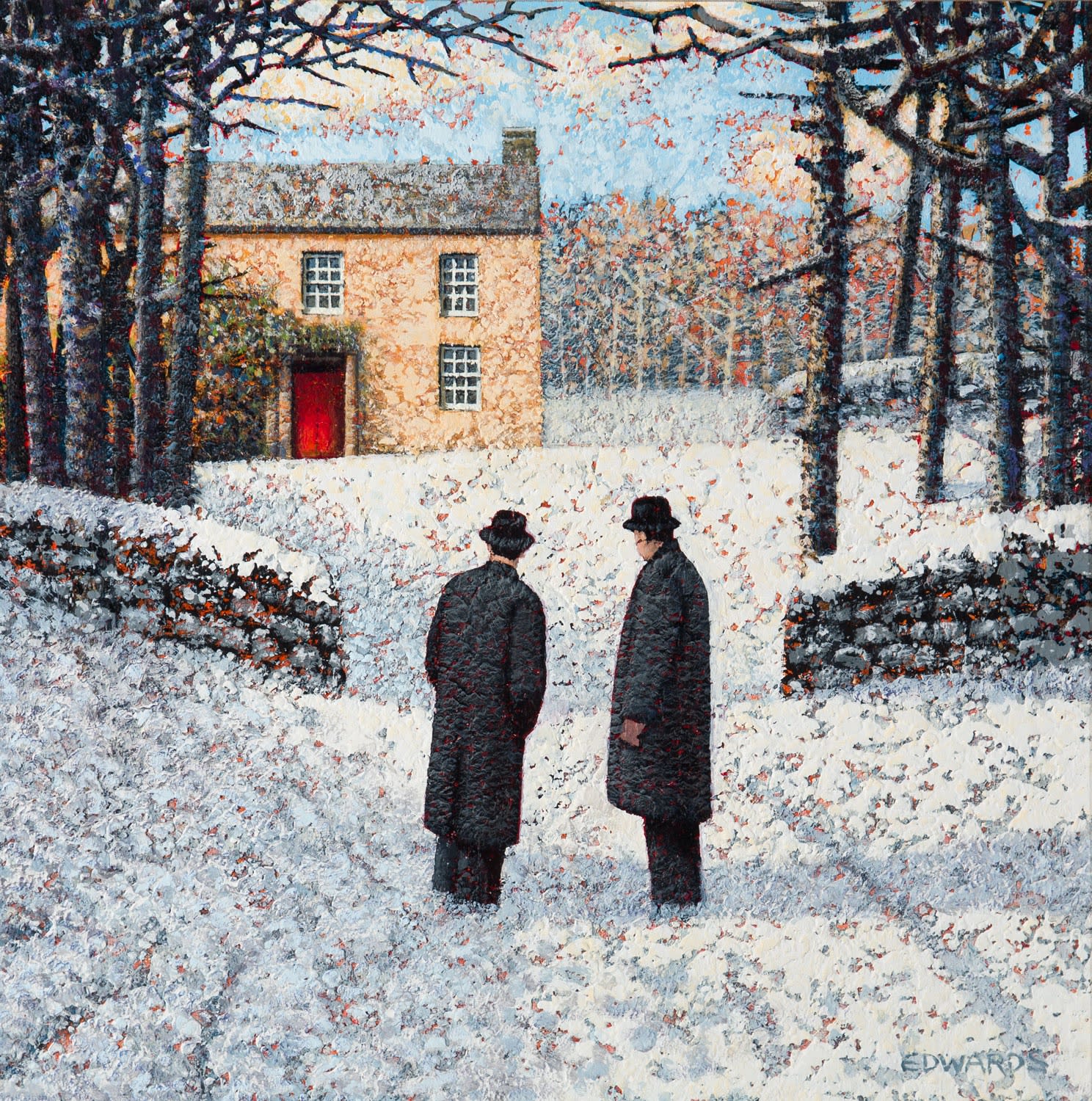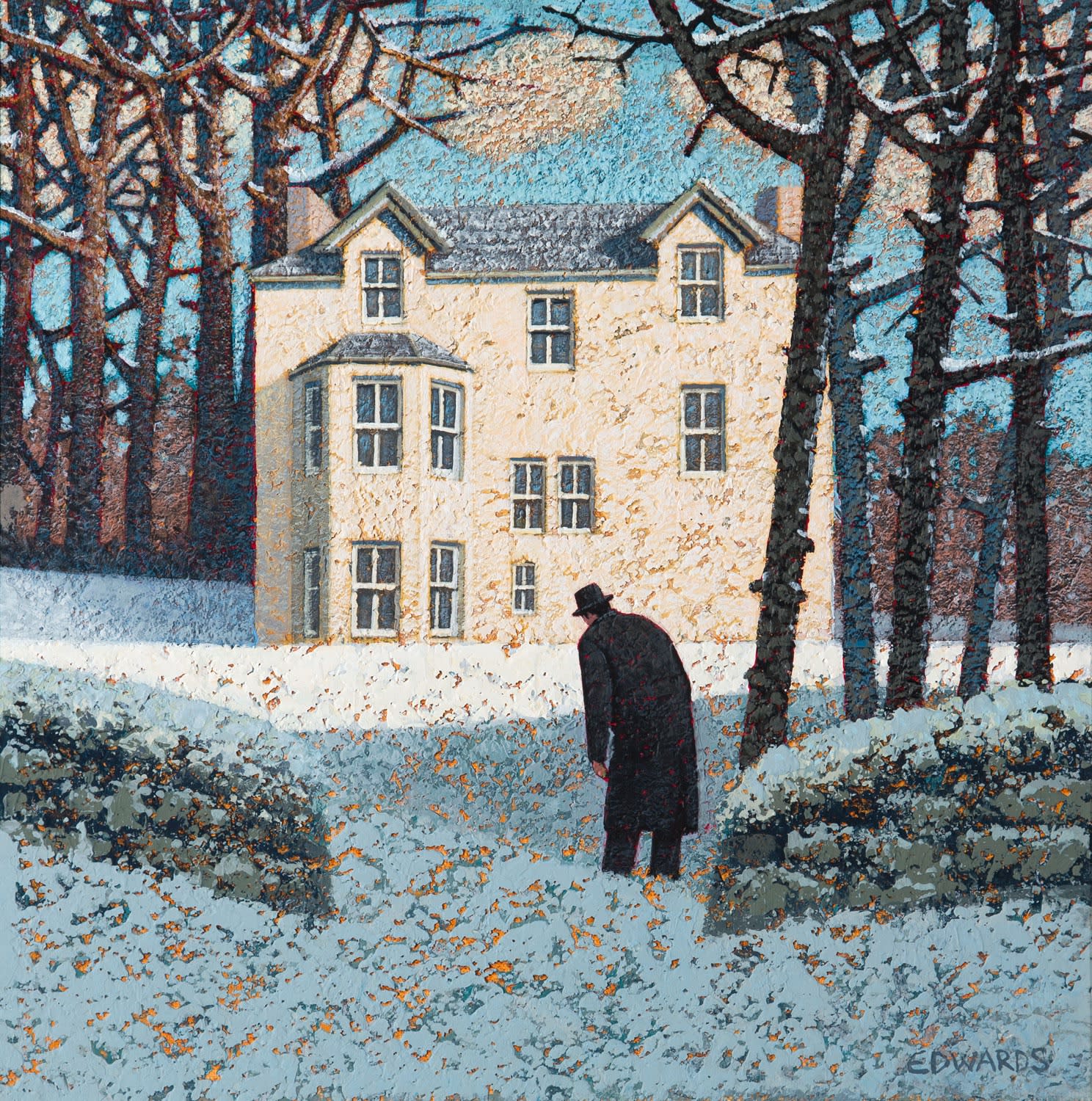
Mark Edwards’ work intentionally resists any prescribed narrative, leaving interpretation blissfully open to the viewer. Part of the joy of his work is becoming lost in your own tales of the ‘White Wood’ and its mysteries. However, at this moment in time, Watching the fire (mixed media, 40cm x 40cm) a resounding statement of where humanity finds itself. Part of this reading resides in Edwards’ experienced handling of materials and composition. The textural density of ice and snow often reveal glimmering embers of underpainting, about to ignite. There’s tension held in the opposing warm/cold palette and in the juxtaposition of subjects out of their natural environments. Male figures in dark suits and Homburg hats, invested with institutional authority are strange visitors to the forest- or do they have dominion here?
In Watching the Fire, the ambiguous figure that stands steadfast and mesmerised as we are, watching the forest burn, could be a bystander, witness or indeed holding the match. As the phrase goes, ‘there’s no such thing as an innocent bystander.’ As the midground snow is engulfed, he doesn’t move, an unsettling posture of presumptive power, married to destruction. As I write that sentence, I’m also aware of the smile on my face, that this highly crafted image can conjure so many stories and that the viewer is invited to project their thoughts so freely into Edwards’ work. Art that can do this offers endless engagement and speculation – a very satisfying game. This isn’t the game of the art world but the game of painting, where play is such an integral part of learning to see and pushing the boundaries, for artist and viewer. Standing as we are on a global tipping point, Watching the Fire doubly resists interpretation as an entertaining diversion. Heightened awareness of danger coupled with the attraction of fire, sums up the best and the worst we are capable of. Human beings can construct anything, imagination is a double-edged sword and the idea of agency hangs in the still air of ‘White Wood’ like a question mark.

MARK EDWARDS | The Balloon | mixed media | 40cm x 40cm
Many people will associate Edwards’ brand of Surrealism (and suited protagonists) with the paintings of Magritte, it is the subversive nature of this work, rather than its style that carries its weight. The sophistication of Edwards’ paintings has its roots in his early work as an illustrator, including book covers for works by Kingsley Amis, Beryl Bainbridge, Sue Townsend, Michael Morpurgo, and Philip Pullman. Knowing how narrative works, understanding human design, the power of visual triggers and archetypes enables Edwards to construct the ‘White Wood’ labyrinth. This series of exploratory paintings, evolving since 2007, have captivated many visitors to the gallery and earned Edwards a devoted following. The effect of this work is like The Balloon (mixed media, 40cm x 40cm), where we momentarily put aside our walking stick and whatever this associative prop represents to us personally, to stand and look up, opened palmed. There’s an element of playfulness and wonder in the hovering red balloon, a childlike state of being so often set aside when a uniform of conformity is donned in adulthood. Edwards’ ‘White Wood’ is a pure imaginative space, but it is also a place where ideas and fantasies can be tested.

MARK EDWARDS | The Other Red Door | mixed media | 40cm x 40cm
In The Other Red Door (mixed media, 40cm x 40cm) two suited men, one inclined towards the other in conference, regard the door of a dwelling inside the mind. Like secret agents on a sting operation, they stand before a series of gateways, in stone, tangled branches and the domestic building beyond. Their focus on this double red door, what is seen and unseen, brings a sense of immediacy to the pin-drop still, snow bound scene. The imaginative terrain is a layered as Edwards’ mixed media and that’s precisely its appeal. With these highly tuned elements in place, inside the picture plane, we can create our own cinematic storylines. Watching a Man Watching a Fire (mixed media, 40cm x 40cm) takes this idea further still, with the foreground shadow inferring that the spectator (or witness) is standing off to the right, in the viewer’s own space. The progression of two figures and shadow read like a visual echo of the individual as viewer and protagonist. Magritte’s subversive use of painting, to unpack the truth and lie of seeing, is more resonant here than the business-man-like costumed figures. The beauty of Edwards’ work is that he offers the viewer an active role in the narrative. Not all art invites this kind of creative dialogue.

MARK EDWARDS | Watching a Man Watching a Fire | mixed media | 40cm x 40cm
Storytelling in all its forms is how we make sense of ourselves and heading into the ‘White Wood’ towards the glow of flames, immediately connects us with deep-rooted psychological territory and hidden emotions. The forest archetype embodies the subconscious, a place of discovery, fairy tales and nightmares, occupying a particularly potent position in the Northern European psyche. Far from a primordial tangle of growth seen in Max Ernst’s Surrealist paintings or the explicit violence of Grimm’s original tales, Edwards’ wood is a wintery, dormant space, settled by vacant lone stately houses and populated by male characters in bureaucratic uniform. Looking at Waiting at the Wall (mixed media, 40cm x 40cm)I’m reminded of Hitchcock’s deadly serious glee: ‘there’s no terror in the bang, only in the anticipation of it.’ The thrill in beholding this lone figure is in imagining how the scene will unfold. This is the artist’s gift to us, to become director and protagonist in a forest of our own making.

MARK EDWARDS | Waiting at the Wall | mixed media | 40cm x 40cm
